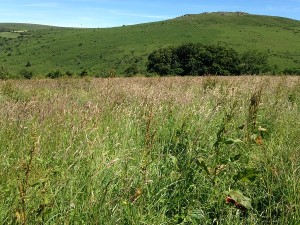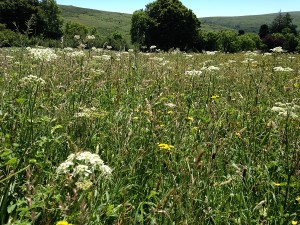Creating a meadow from rough grass or lawn
Key facts to understand
- It is important to ‘cut & collect’ to mimic animals grazing (use to make compost)
- Don’t hesitate to cut the meadow where there are still some flowers, if you wait until there are no flowers you will end up with dominant species such docks and knapweed
- There is no need to remove top soil as a means to reducing fertility, instead establish Yellow Rattle (Rhinanthus minor)
Reasons to create wildflower meadow
- Massive decline in insects species and numbers
- Insects (including bees) tend to be underweight, infected (imported diseases) and stressed (loss of habitat) all at the same time
- 70% of bee friendly plants sold by leading garden centres contain neonicotinoids (systemic insecticide)
- Reduce mowing, saves time and money
- Attractive, brings wildlife into the garden (insects & birds) and helps biodiversity

This is a meadow which is full of coarse grasses (e.g. Yorkshire fog) & docks, very few flowers. Tall grasses smother wild flowers; more grass than flowers.

This meadow has not been ploughed nor treated with fertilizers for at least 50 years, there are over 20 different species/m2. Lots of fine grass species; more flowers than coarse grasses.
Yellow rattle
Yellow rattle is a semi parasitic grassland annual, it reduces the vigour of grass and allows wildflowers to establish and thrive, it also reduces mowing requirements. It loves Yorkshire Fog grass and Cocksfoot grass.
Yellow rattle is established from seed in September (no later), sown onto bear soil (e.g. upturned 1m2 patches of turf*) although it germinates February / March (requiring the winter chilling). Establishment can be unpredictable (for example the cold wet spring of 2016) however it usually establishes very well, taking 2-3 years to build up. Use fresh seed sown at a rate of 0.1-1g/m2 (less is required in the shade where grass is weaker, more is needed where grass is strong).
* Different ways of creating bare gaps in the sward
Cut the grass short in the autumn then:
- Lift and flip over 1m2 patches of turf at intervals throughout the meadow area
- Harrow or rotavate strips at intervals (e.g. up hill) aiming to expose 50% bare soil
- Winter grazing with stock (e.g. sheep) as their hooves open up the sward
How & when to establish wild flowers
Delay trying to establish wild flowers in your sward until you have got a good cover of yellow rattle, this may take up to 3 years. Then plant small 9cm plants into the sward or use ‘Green Hay’ from another meadow (contact other meadow owners, for example members of the Moor Meadows group below sell this). Expose some bare earth then spread fresh green hay (same day as it is cut).
If you have a very small area of land that you want for a meadow (e.g. 5m x 10m), rotavate it all, sow yellow rattle (September) and plant wildflower pots and plugs (e.g. scabious, knapweed, betony, bedstraw… depending upon the soil and aspect). You could do the ‘stale seedbed’ technique prior to sowing yellow rattle.
Stale seedbed method – prepare the bed as if it was ready for planting but instead of planting water it and allow all the weeds to grow, then without any futher digging, spray off the weeds then sow / plant.
Pests
Rabbits love to dig up freshly planted pots, you might need to put some chicken wire over the top for the first few months.
When to cut
You do not have to stick to exact times each year, the most important thing is to cut 4 times each season. If you have a very large area, you can divide it up and cut at slightly different times.
- Cut when the grass first falls over
- Then cut the new growth twice during the summer (on a high mower setting)
- Give a final cut at the end of the summer
Cutting tools
Strimmer, sythe, mower on high setting if it can cope with long grass althernatively a sythe mower or tractor mounted topper.
References
Notes by Angela Morley (www.wildgardens.co.uk) taken from Meadow Makers Conference 1/7/17 https://www.moormeadows.org.uk/
Further information
http://www.charlesflower-wildflowers.co.uk/
http://sueeverettmeadowmaker.blogspot.co.uk/
http://www.wildflowerturf.co.uk
http://www.magnificentmeadows.org.uk
http://www.caringforgodsacre.org.uk/
http://butterfly-conservation.org
https://bumblebeeconservation.org